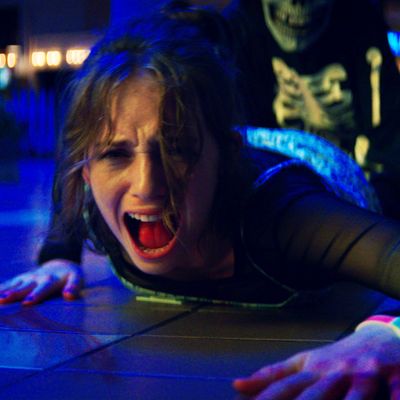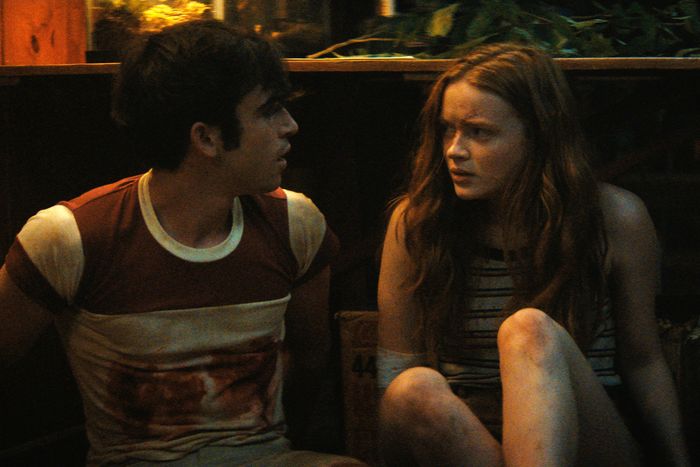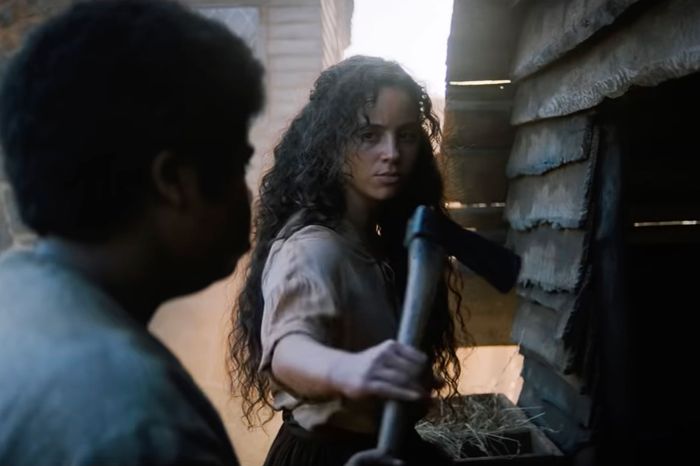
The first Fear Street premiered on Netflix on July 2. Vulture will be reviewing each installment of the trilogy as they release here.
Fear Street: 1994
I’m pathetically in the bag for arthouse horror. I like my dread slow-dripped and my scares born more out of cunning camera angles and disturbing imagery than shock-y jumps. Give me a film that’s as haunted by the traumas of its characters as by its killers, ghosts, and ghouls, and I’m already halfway onboard. And yet, I’ll confess to feeling a sense of relief on realizing that the kickoff Fear Street film wasn’t about more than it says on the package. Fear Street Part 1: 1994 is a nasty, effective slasher about a group of teenagers who come into contact with the curse that’s been plaguing their town of Shadyside, Ohio, for three centuries — one that has something to do with an accused witch, Sarah Fier, who was hanged in a settlement in the area back in 1666. At no point during the movie, which is the first installment of a trilogy that Netflix will be releasing (and I’ll be reviewing) over three weeks, is there a suggestion that the curse is a metaphor for repressed sexuality, or industrialization, or anything else. Sometimes a curse is just a curse, and this one has periodically sparked murder sprees in Shadyside, which is tattered and struggling, while the nearby community of Sunnyvale thrives.
Horror is hardly the only film genre that’s fallen under self-exerted pressure to seek out greater, or at least more explicit, relevance, but it’s the one in which the gap between theme and execution can feel most glaring. The trouble with the “actually, it’s about trauma” or “actually, it’s about racism” approach is not the ambition to deal with these themes onscreen, but that so many recent movies (and TV shows) just stop after making the connection because they don’t actually have anything to say about these concepts. Where Get Out or The Babadook used horror to explore the razor-toothed hunger of white liberal (supposed) allies and the terror of feeling unable to trust your own mental state, plenty of other titles end up just pinning themselves to larger concepts in ways that range from clumsily obvious to grossly cynical. But 1994 feels untethered from these obligations. Its characters — band goth Deena (Kiana Madeira); her chatroom-loving younger brother, Josh (Benjamin Flores Jr.); her drug-dealing pals Kate (Julia Rehwald) and Simon (Fred Hechinger); and her ex, Sam (Olivia Scott Welch) — aren’t flat in terms of demographics or personal histories, but their differences exist within the context of the movie without being the triple-underscored point.
Deena’s pining for and rage at Sam, who moved to Sunnyvale after her parents’ divorce and started dating a football player after Deena dumped her, is not the reason the curse is called down on these kids, but it is the film’s moody emotional core. The connections between the five are why they find themselves doing battle with a force that resurrects its past victims, among them an ax-wielding killer, a teen queen with a razor blade, and a stabby type in a skull mask. The latter is right out of Scream, as is the film’s first sequence, in which a disaffected B. Dalton employee named Heather (Maya Hawke) meets her gruesome end when closing up after hours in the Shadyside Mall. The trio of films, which were all directed and co-written by Honeymoon’s Leigh Janiak, are based on a series of R.L. Stine novels aimed at an older (which is to say, teenage) audience, and were originally slated to be part of an R-rated theatrical gamble at 20th Century Fox. On Netflix, the content of 1994, which includes some gnarly killing — Heather’s is on the milder end, and she doesn’t go easily — feels less remarkable than the quality of its filmmaking. That opening scene is shot in a retail expanse that’s as pretty as it is spooky — glowing in muted neon lighting, Heather goes down in a slow motion that lends a little lyricism to her pre-credits death.
Those credits handily lay out a timeline of divided communities and occasional bloodletting that harkens as much back to horror’s history as it does the fictional twin towns. The ax-murderer, for instance, evokes Jason Voorhees, and will presumably show up in the next installment, 1978, which will take place in a summer camp that was demolished and replaced with the mall. But 1994 isn’t a pastiche, and it tries to evoke the actual decade in which it’s set and not an air-quotes version, with some nicely chosen needle drops (like the Cowboy Junkies’ inescapable-at-the-time cover of “Sweet Jane”) and restrained costuming choices.
While the film has obvious touchstones, the influence it quietly but most steadily brings to mind is the terrific (and admittedly very arthouse!) It Follows. Like David Robert Mitchell’s film, 1994 takes place in a suburban world that’s familiar and also borderline dreamlike — an inciting hazing incident starts with headlights zooming in from afar in the night, as seen through the windows at the back of a school bus. And like It Follows, the curse in 1994 involves inexorable pursuers that the gang tries to fight off with MacGyver’d solutions, with parents remaining indifferently offscreen and most other adults revealed to be oblivious or skeptical. But Janiak’s film is saltier, soapier, and more pragmatic — it has sequels to dole out, after all. In 1994, it’s not sex that invites the monsters in, but making contact with evidence of the town’s original sin, one that we’ll presumably eventually witness. That may speak to a grander theme in its own right, but it’s not one any American horror film ever has to overreach for, not when its been there in the background all along.
Fear Street: 1978
The way I understand it, Shadyside and Sunnyvale aren’t rival towns so much as they’re the severed halves of one big high-school cafeteria. All the jocks, rich kids, popular types, and preppies are clustered on one side, thriving in Sunnyvale, while trapped in Shadyside are the oddballs, burnouts, folks without money, and outcasts. How a pair of individual communities could maintain this makeup over so many years is explained by the revelation, in Fear Street Part Two: 1978, that they used to be one and the same — a 17th-century settlement called Union. Witch Sarah Fier’s curse didn’t just break Union in half, it consigned one side to a morose, supernaturally enforced townie-dom. Characters like pill-dealing cheerleader Kate (Julia Rehwald) in the first film and perfectionist Cindy (Emily Rudd) in the second devote themselves to different strategies for getting out that work out equally poorly. Who could blame them for trying, when the adults of Shadyside — as much as we see them — all seem resigned to leading lives of alcoholism, loneliness, or resentment? Camp Nightwing survivor C. Berman (Gillian Jacobs) turns out to have opted for a little of all three.
The thought of never being able to escape the labels put on you in high school is terrifying indeed, though as a horror film, the second Fear Street installment is messier and less effective than its predecessor. 1978 is to Friday the 13th as 1994 was to Scream, taking place at a summer camp that has the misfortune to have been built on the site of Sarah Fier’s hanging, and that’s soon being attacked by an ax-wielding murderer. The killer’s no mysterious stranger — he’s Tommy (McCabe Slye), Cindy’s boyfriend and fellow counselor, who starts hearing voices not long after the camp nurse, Mary Lane (Jordana Spiro), tries to stab him for what she says is the greater good. Mary’s the unfortunate mother of Ruby Lane, the girl who slashed up seven of her friends, then herself, a decade or two earlier. She’s been doing research into Sarah Fier, who apparently doesn’t need to come into contact with someone via her remains to take control of them. She takes over Tommy by carving his name on her stone wall of victims, the way she did with Sam (Olivia Scott Welch) at the end of the first film. In 1994, Deena (Kiana Madeira) and Josh (Benjamin Flores Jr.) roll up to C. Berman’s house with the possessed Sam in their trunk, looking for a way out of what’s happened to them.
Part two of Fear Street is still cheerfully allegory averse, fueled instead by the intense, unfiltered emotional state of its teenage characters. And the most intense emotions of all belong to Cindy’s sister Ziggy (Stranger Things’ Sadie Sink), a rebellious analogue to Deena, who wears her defeatism proudly and can’t understand why her estranged older sibling has seen fit to reinvent herself as an uptight snitch. Like the first film, 1978 tries to inhabit its era rather than present an air-quotes version of it, courtesy of frequent needle drops (one of which, the Velvet Underground’s “Sweet Jane,” bookends the cover used in the first film) and costuming. But the most period-appropriate aspect of it is how little effort is put into mitigating the cruelty the kids prove themselves capable of. While the counselors are busy fucking and fighting among themselves, Ziggy gets hazed by Sunnyvale mean girls who burn her with a lighter. For color wars, the campers are divided up by town to exacerbate the hostilities between the communities even more. The laxity is such that Nurse Lane’s murder attempt doesn’t appear to merit an appearance from a single concerned parent.
Then again, the whole point of summer camp is that it’s a world without all the standard adult supervision — that edge of adolescent chaos is what makes it such a ripe setting for horror films. But that’s also why 1978 has a harder time than the first installment — it’s a slick production trying to emulate the quality of ragged unpredictability that makes the best summer-camp horror flicks so memorable. Instead of replicating those organic qualities, it ends up just feeling a little scattershot, as its characters are split up across the camp, some of them navigating creepy tunnels underground, others taking shelter in the science building, and an unlucky selection taking an ax to the face or the chest. As the project tries to fight its way past homage and irony to simply be about the shrieky pleasures of watching teens be stalked by blade-wielding menaces, it’s also burdened with trying to tell a more ungainly overall story that will loop together decades, something that makes this purported trilogy of films feel more like a miniseries. 1978 does manage to further get at something that 1994 hints at, and that makes the dramatic nihilism of the films’ teen heroines more piquant. The worst part of living in Shadyside isn’t the sense of that failure is inevitable — it’s having having a whole town of people who aren’t subjected to this feeling right down the road.
Fear Street: 1666
The Fear Street trilogy could have been utter garbage, and its existence still would have been justified by the brief tour of Satanic interior design that we get toward the end of Fear Street Part Three: 1666. The house in question belongs to the Sunnyvale character revealed to be a present-day beneficiary of the centuries-long curse affecting the neighboring town of Shadyside. The walls are decorated with equal parts mounted goat heads and inspirational posters, and a family tree sits above the hearth, flanked by black candles. The carpets are an impractical cream color, the chairs leather Le Corbusier, and the media room includes a hefty vinyl collection and a jukebox. It’s bachelor-pad chic by way of demonic worship, and a nifty visual punch line to close out the three-film story. Here’s what generations of being complicit in years of ritual sacrifice can net you — a local government position of questionable prestige and a tacky McMansion in the suburbs.
The Fear Street trilogy isn’t utter garbage, though it never does get back to the fizzy highs of its 1994-set first installment. The final film, 1666, does loop back around to Deena’s (Kiana Madeira) efforts to end the curse and free her girlfriend Sam (Olivia Scott Welch) from the grip of possession, but not before a trip back to where it all began: the 17th-century settlement of Union, a Puritan community that’s a little early to what was then a French colonized region. But what does history have on gestures to the number of the Antichrist? The film isn’t exactly concerned with replicating The Witch–level period detail — early on, the teens sneak off into the woods for an old-timey kegger, where they get wasted on applejack and hallucinogenic berries. Sarah Fier, the future witch, is one of them, and for most of the interlude, she appears as Deena, who’s been given a magical glimpse into the past. Most of the other town residents are played by actors from the previous films as well, with Olivia Scott Welch once again playing the love interest, Benjamin Flores Jr. the little brother, and Jordana Spiro the creepy healer lady, this time a widow exiled to the woods.
Ashley Zukerman, who plays Sheriff Nick Goode, is back too, this time as early Goode family ancestor Solomon, who, despite being related to Union’s leadership, is struggling to make a life for himself as a farmer outside the settlement. The Goodes, it seems, have a legacy of sons who want to prove that they’re different, only to eventually join the fold and take advantage of what they’ve been gifted. It’s not a revelation to learn that Sarah was, like all accused witches, targeted out of resentment and because she’s different. Spiro, who played the tragic Nurse Lane in 1978, is a widowed healer in this film, a living reminder of what can happen to recalcitrant women — exiled from the community for either sacrificing her husband to the devil or, more plausibly, being too friendly with the local Indigenous population. Sarah, who’s good with livestock, bad with following rules, and gay, doesn’t stand a chance when a blight starts to affect the produce, causing food to putrefy on the table and the farm animals to start eating their young. The betrayal Deena witnesses in the past fuels her efforts to take revenge in the present, though the big showdown largely rehashes the finales of the previous films.
Fear Street has felt, throughout its run, like an attempt to recast classic horror ideas and images in a contemporary mode — all those slashers, summer camps, and Satan-worshipping witches — without wallowing in self-reflexive air quotes or forced thematic importance. And while it has succeeded in that, the trouble it does create for itself has everything to do with the very modern hybrid format this trio of features have taken. Fear Street exists in this strange space between movies and television, serving neither format well in the way it tries to service stand-alone and ongoing stories. It’s labeled a trilogy, but the second and third installments don’t really function as movies at all, with their attempts to create coherent dramas in what amount to sustained flashbacks, while also lugging along updates in the continuing saga of Deena & Co. The strange truth about this horror-movie refresh is that it ends up treating the movie format as just another throwback artifact, a fun idea from the past that it’s not committed to on any deeper level. Fear Street is already halfway to being a TV series, and ultimately plays like it should have just leaned all the way into that impulse, doling out episodes to some of Shadyside’s other killers and allowing its central mystery more time to be solved. That way, maybe, we could have gotten more details like that house interior, a textural touch that’s creepier and funnier than having the same set of killers come back again and again.
More Movie Reviews
- The Accountant 2 Can Not Be Taken Seriously
- Another Simple Favor Is So Fun, Until It Gets So Dumb
- Errol Morris Has Been Sucked Into the Gaping Maw of True Crime




